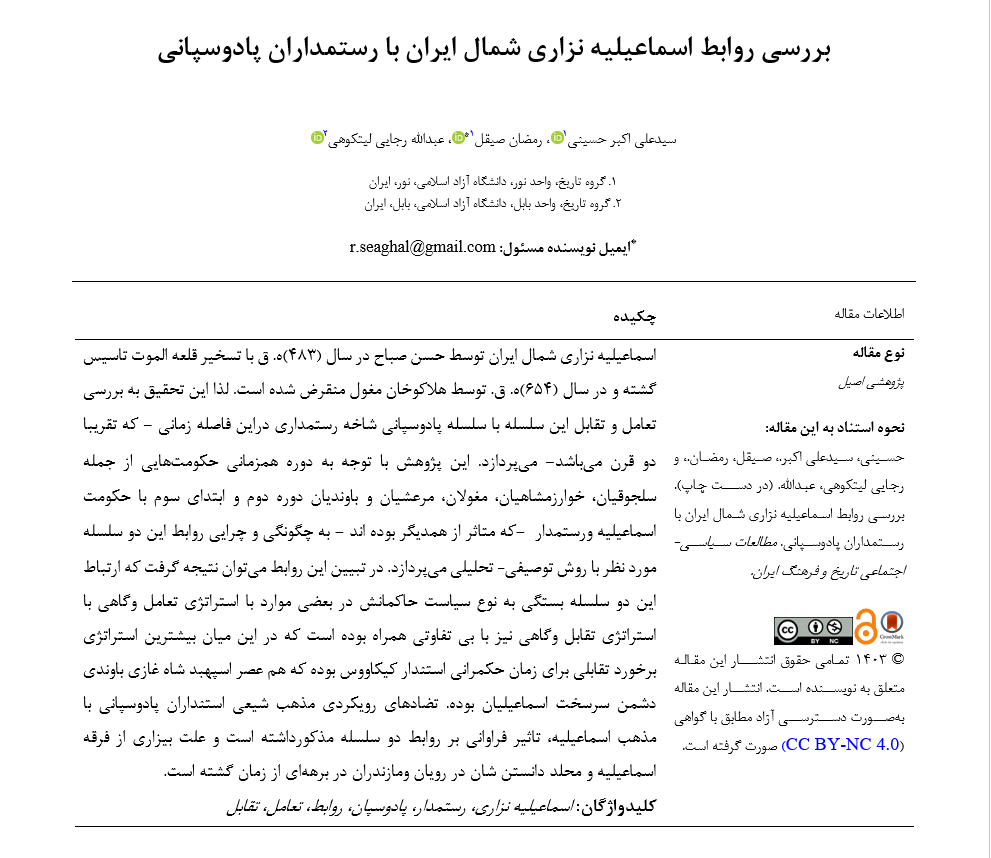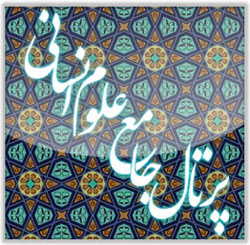بررسی روابط اسماعیلیه نزاری شمال ایران با رستمداران پادوسپانی
کلمات کلیدی:
اسماعیلیه نزاری, رستمدار, پادوسپان, روابط, تعامل, تقابلچکیده
اسماعیلیه نزاری شمال ایران توسط حسن صباح در سال (483)ه. ق با تسخیر قلعه الموت تاسیس گشته و در سال (654)ه. ق. توسط هلاکوخان مغول منقرض شده است. لذا این تحقیق به بررسی تعامل و تقابل این سلسله با سلسله پادوسپانی شاخه رستمداری دراین فاصله زمانی - که تقریبا دو قرن میباشد- میپردازد. این پژوهش با توجه به دوره همزمانی حکومتهایی از جمله سلجوقیان، خوارزمشاهیان، مغولان، مرعشیان و باوندیان دوره دوم و ابتدای سوم با حکومت اسماعیلیه ورستمدار -که متاثر از همدیگر بوده اند - به چگونگی و چرایی روابط این دو سلسله مورد نظر با روش توصیفی- تحلیلی میپردازد. در تبیین این روابط میتوان نتیجه گرفت که ارتباط این دو سلسله بستگی به نوع سیاست حاکمانش در بعضی موارد با استراتژی تعامل وگاهی با استراتژی تقابل وگاهی نیز با بی تفاوتی همراه بوده است که در این میان بیشترین استراتژی برخورد تقابلی برای زمان حکمرانی استندار کیکاووس بوده که هم عصر اسپهبد شاه غازی باوندی دشمن سرسخت اسماعیلیان بوده. تضادهای رویکردی مذهب شیعی استنداران پادوسپانی با مذهب اسماعیلیه، تاثیر فراوانی بر روابط دو سلسله مذکورداشته است و علت بیزاری از فرقه اسماعیلیه و محلد دانستن شان در رویان ومازندران در برههای از زمان گشته است.
دانلودها
مراجع
Ameli, O. e. A., & Sotoudeh, M. (1969). History of Royan. Iran Culture Foundation Publications.
Arif, T., & Zomorudi, H. (1998). Ismailia and Qaramat in History. Jami Publishing.
Barzegar, A., & Fumshi, M. S. (2001). the history of Tabarstan. Rasanesh.
Daftari, F., & Badrhai, F. (1996). History and Beliefs of Ismailia. Farzan Rooz.
Farhani Monfared, M. (2014). Diplomacy of expansion and dialogue; a study on the political struggles of the Ismailis of Alamut. Farhang Magazine, 75-108.
Gilani, S. A., & Sotoudeh, M. (1973). History of Mazandaran. Iran Culture Foundation Publications.
Hakimian, A.-F. (1989). The Alawites of Tabaristan: A Study of the Conditions, Works, and Beliefs of the Zaydi Sect of Iran. Ilham Publishing House.
Hamedani, R. a.-D. F., Roshan, M., & Panahi, A. (2008). Jami' al-Tawarikh, History of the Ismailis. Publisher of Written Heritage.
IbnEsfandiar, B. M. I. H., & Ashtiani, A. (2010). History of Tabarestan. Nashr-e-Satir.
Irfan Menesh, P. (2019). Examining the spread of Ismailism in Iran.
Ismaili, Y. (2008). A journey through the history of Shiism in Mazandaran (from the beginning to the end of the 8th century A.H.). Research Institute of Islamic Sciences and Culture.
Jovini, A., & Qazvini, M. b. A. a. W. (1999). Tarikh Jahangashai Jovini (Vol. 3). Bammad.
Khorasani, F., & Simeonov, A. (1994). Muhammad bin Zayn al-Abidin, History of the Ismailis with the Guidance of the Believers and the Learned. Mythology Publications.
Maqrizi, T. a.-D. A. i. A., & al-Shayal, J. a.-D. (1948). Al-Hanafa's preaching on the news of the Fatimid Imams and Caliphs.
Marashi, Z., & Tasbihi, M. H. (1968). History of Tabarestan, Royan and Mazandaran. Shargh.
Mashkoor, M. J. (2011). History of Shia and Salam sects until the fourth century. Eshraghi Publishing House.
Mirkhwand, & Kianfar, J. (2001). History of Rawdah al-Safa in the lives of the Prophets and the Muluks and the Khalifas.
Moein, M. (1984). Farhang Moein (Vol. 5). Nasherspehr.
Najmi, N. (2010). The Story of Hassan Sabah and the Castle of Alamut. Arghavan Publications.
Rodger Kia, I. (2015). Standard history (Royan and Dilam Zameen). Parpirar.
Sasanpour, S., & Qara Daghi, M. Y. R. (2019). Political and Ideological Conflicts of Ismailis of Nizari and Baundians of Tabaristan in the Seljuk Era. New Attitudes in Human Geography Quarterly, 11(3).
Shabankarei, M. b. A. b. M. (1997). Al-Ansab Majam. Amir Kabir.
Shuja, S. (2006). A Thousand-Year History of Islam in the Northern Regions of Iran. Eshehar Publishing.
Shushtri, A. G. N. (1998). Majlis al-Momenin (Vol. 1). Islamic Publications.
Stern, S. M. (1949). Ismaili propaganda and fatimid rule in Sind. Islamic Culture, 23, 298-307.
Stern, S. M., & Badrei, F. (1997). The beginning of Ismaili preachers in the northwest of Iran, Khorasan and Mavar al-Nahr. Faculty of Literature magazine, 14(1), 24-69.
Willy, P. (2005). The Eagles Nest: Ismaili Castles in Iran and Syria. I.B.Tauris.
Yousefi, S. (2014). Historical Geography of Royan and Rostamdar. Rasash Novin.
Yusefnia, A. A. (1977). Langa. Ministry of Culture and Arts Publications.

دانلود
چاپ شده
ارسال
بازنگری
پذیرش
شماره
نوع مقاله
مجوز
حق نشر 2025 سیدعلی اکبر حسینی (نویسنده); رمضان صیقل; عبدالله رجایی لیتکوهی (نویسنده)

این پروژه تحت مجوز بین المللی Creative Commons Attribution-NonCommercial 4.0 می باشد.







